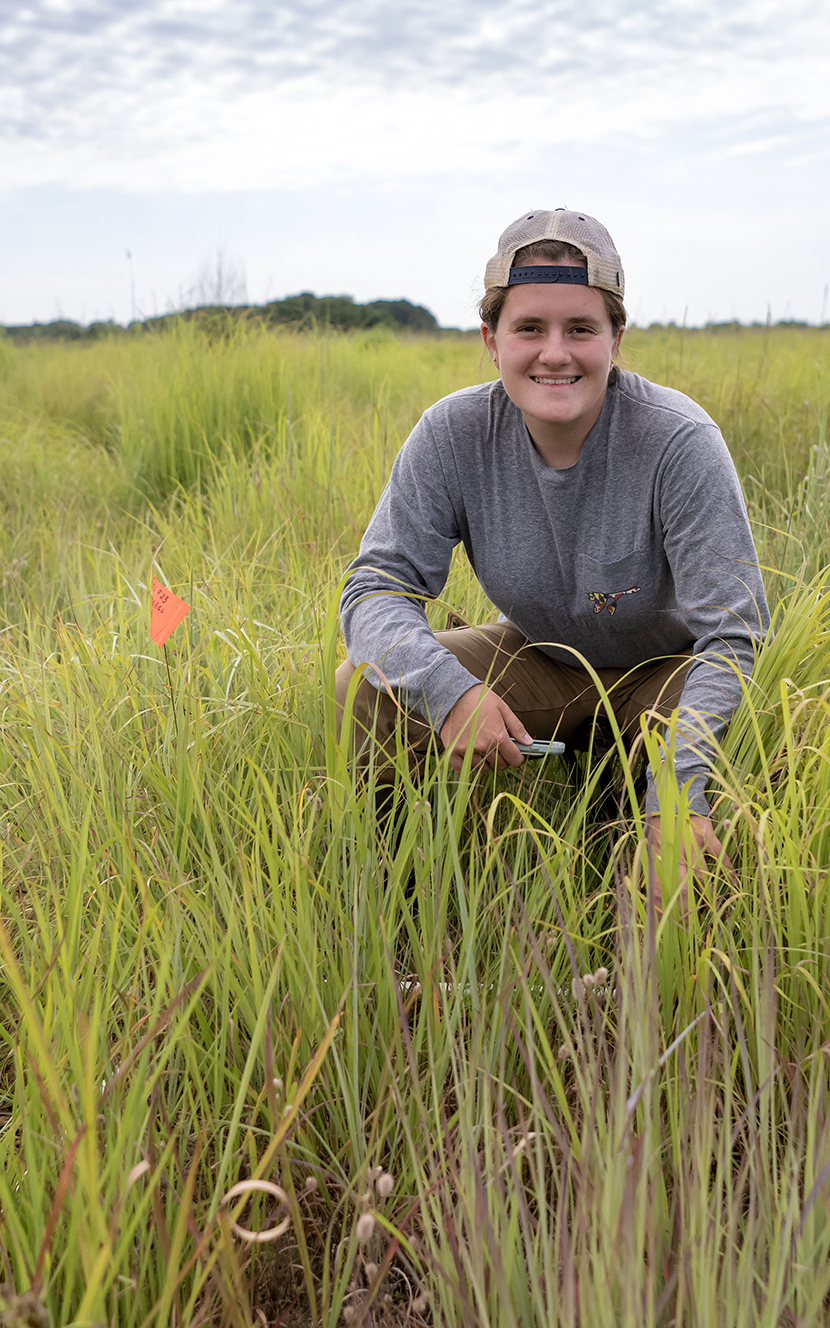
MAJORS AND MINORS
- Biology and Environmental Science Majors
- Chemistry Minor
EXPERIENTIAL LEARNING
- "I like this Toll Fellows program because I’ve gotten a good sampling of every job you could have in a biology setting: collecting, inputting, identifying, data analysis, writing up results, and presenting. If you want to go into a biology field, you can’t understand it until you do it.”

The Effects of Prescribed Burns on Biodiversity
Danielle Simmons '26
Still Pond, MarylandMAJORS AND MINORS
- Biology and Environmental Science Majors
- Chemistry Minor
EXPERIENTIAL LEARNING
- "I like this Toll Fellows program because I’ve gotten a good sampling of every job you could have in a biology setting: collecting, inputting, identifying, data analysis, writing up results, and presenting. If you want to go into a biology field, you can’t understand it until you do it.”
One tool for preventing grasslands from growing into forests is prescribed burns, which are used every couple of years to raze everything above ground. This allows grasses, flowers, and other quick-growing groundcover to reemerge from their intact root systems while woody plants like trees and shrubs that would eventually overtake the grasses are kept in check.
While this benefit of prescribed burns is well-understood, there remain many details for science to fill in. This summer, Simmons has had the opportunity to contribute to that effort in a project overseen by Katherine Hovanes, a visiting biology professor.
In addition to helping private landowners like the Simmons family and public lands like Eastern Shore state parks maintain grasslands, NLP also manages 12 contiguous fields on the River and Field Campus (RAFC), which were planted with one of five different seed mixes 25 years ago and have been maintained by rotating prescribed burns. Although highly weather-dependent, the burns are conducted twice a year, in the fall and spring, on just some of the fields each time. Each parcel of land is burned every two years.
The RAFC grasslands provide NLP with useful demonstration properties to share with landowners considering joining the effort and are a valuable opportunity for ongoing research.
Hovanes and Simmons spent the beginning of the summer recording the species of plants they found in random, one-meter-square plots throughout four of the RAFC fields, each of which is further subdivided into quadrants that are burned on differing schedules. They selected four fields with as few bird nests as possible, to avoid interfering with either the birds or the ongoing nesting research.
While they are still analyzing their data, Simmons and Hovanes have already found just through the process of collecting and cataloging the plant specimens that some of the fields have up to 30 different plant families.
“When you look at a grassland, you don’t think there are going to be 30 different plant families,” Simmons said. “The study is going well. We’ve definitely gotten a lot of data.”
The research found 102 species total across all of the fields studied, with nine to 15 species per meter-square plot in most cases, although the most diverse plot had 22 different species.
Simmons and Hovanes noted that their study could be a first step in updating best practices for prescribed burns to enhance grassland biodiversity, which is an indicator of ecosystem health because more diverse areas tend to be more resilient to challenges like drought, disease, or extreme temperatures. In addition to considering the burn schedule, their study also factors in the different initial seed mixes planted in each field. Along with quantifying the biodiversity of plots, they are measuring the percentage of bare ground and plant litter, all of which can affect the suitability of the habitat for ground birds like the northern bobwhite quail, a species of particular focus for the NLP.
While the NLP has maintained the grasslands that make this research possible, the study itself could only happen because of the John S. Toll Research Program. Hovanes said its funding was vital for two essential reasons: paying undergraduate students removes a barrier for them to be able to spend their time on research, and early-career faculty members, like Hovanes, can have trouble receiving grant money from external sources to support their research.
“Among liberal arts colleges, Washington College is fairly different in that it has an established program to support undergraduate research,” Hovanes said. “If Danielle had not been sponsored by the Toll Program, we wouldn't have been able to do a project of this size.”
Hovanes said that because Simmons grew up on a farm—where she continues to live and work while attending Washington—she didn’t need much training on how to conduct field work or do it safely. She added that Simmons’ work ethic, interest in botany, and motivation helped her undertake much of the specialized, time-consuming labor inherent in the research project. Simmons will also get to share the results of the study at Homecoming Weekend this fall as part of the Toll program and potentially at an Ecological Society of America meeting in Baltimore next summer.
The biology and environmental science double major said she has been learning a great deal through the program this summer, from details about different species of grasses to the many aspects of scientific work.
"I like this Toll Fellows program because I’ve gotten a good sampling of every job you could have in a biology setting: collecting, inputting, identifying, data analysis, writing up results, and presenting,” Simmons said. “If you want to go into a biology field, you can’t understand it until you do it.”
— Mark Jolly-Van Bodegraven